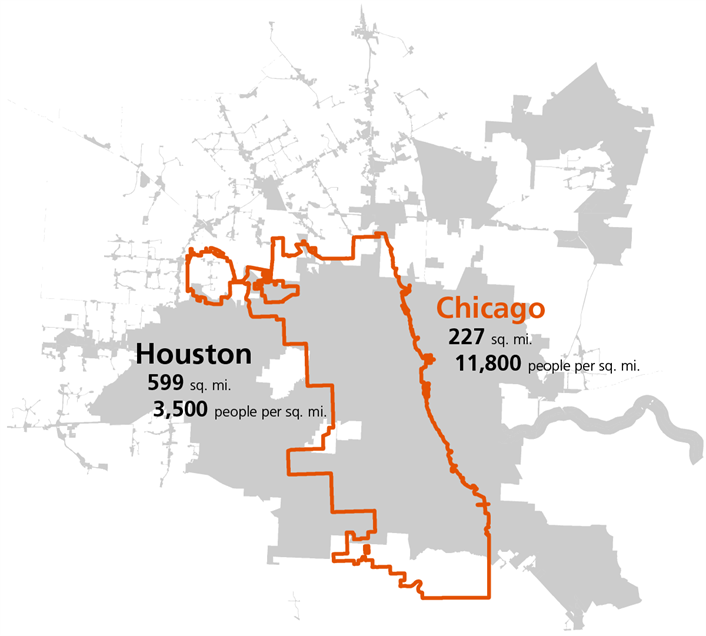
Eytan Uliel
Houston is growing, but at what cost?
This week headlines screamed that within the next decade Houston will take Chicago’s spot as third most populous city in the U.S.
Houston is projected to have a population of 2.54 million to 2.7 million by 2025, while Chicago will be at 2.5 million, according to official data from the health departments of both states, analyzed by Reuters.
It’s true Houston has long been one of the fastest growing cities. The city itself grew by 1.6 percent last year, while Chicago grew a sad 0.003 percent (yes, that’s three decimal points to the right).
And the Houston Metropolitan Area has been one of the fastest growing in the country. Over the next 15 years the entire Houston region is projected to grow by 34 percent, while the Chicago region is projected to grow at only 7 percent.
What’s fueling Houston’s growth?
Jobs (specifically the energy sector), low taxes and low cost of living are fueling Houston’s growth. My recent analysis of Chicago region migration data found Texas to be the number one state people move to that doesn’t share a border with northeastern Illinois. Austin, Dallas and Houston all have significantly lower costs of living but people make about the same income as residents of Chicago. In other words, your dollar goes further in Houston: a house will run you about $125,000, compared to $211,000 in Chicago.
Houston’s unemployment rate stands at 4.7 percent, Chicago’s at 5.9 percent. And the kicker: employment data show that the Houston region gained about 630,000 jobs from 2005 to 2015, while the Chicago region only added 89,000.
But what about sprawl?
That all looks pretty rosy for Houston, but here’s the issue: Houston’s growth comes at a cost: mainly sprawl, poor air quality and traffic congestion. In fact, Houston may be the very definition of sprawl. According to the U.S. Census, at 599 square miles the city is more than double the area of Chicago’s 227 square miles. Houston's population density is much lower, with only 3,500 people in each square mile compared to 11,800 in Chicago. The City of Houston is larger than the combined area of Philadelphia, Detroit, Baltimore and Chicago. In total, those four cities have a population of 5.5 million people, or 3 million more than Houston, living in the same amount of space.

In Houston, 75 percent of people drive alone to work compared to 50 percent in Chicago. Houston has virtually no public transit, while Chicago has one of the best systems in the country, with 30 percent of commuters taking transit, rather than cars, to work every day. And 8 percent of Chicagoans do the healthy thing and walk or bike to work, compared to less than 3 percent in Houston.

Motorola is moving offices to downtown Chicago, citing the benefits of access to transit.
Chicago is thinking strategically by targeting dense development near transit, our ticket to growth. People are driving less and they want more transportation options. Development near transit helped double Chicago's downtown population between 2000 and 2010, even as the city as a whole lost population. Businesses want to be near transit to attract the best talent. Just this week, Motorola announced a move to downtown Chicago: “The high-tech talent we need to recruit, such as data scientists, user experience designers, interface designers, software application engineers, they’re located [downtown]. And this building is just steps from the major train stations and a few blocks from the city train stops which will be important to our people.”
The city of Chicago has one of the nation’s most extensive public transportation systems, and jobs and population have followed. Today, 42 percent of the city’s land is located within a half-mile of a Chicago Transit Authority or Metra rail station, and 51 percent of the city’s population and 76 percent of its jobs are within that same distance. Since 2005, 65 percent of new building permits and city-subsidized affordable housing units have been recorded within that same half-mile radius from transit.
That’s good news, because transit-oriented development encourages people to spend more money at local business, use transit more, relieve congestion and contribute to a more sustainable environment. It increases opportunities for job-seekers and reduces overall municipal expenditures. It also allows more people of all types—young, old, rich and poor—to have access to opportunities that otherwise are available only to those who can drive their own cars.
The Metropolitan Planning Council (MPC) supports Mayor Emanuel’s recently introduced amendment to the 2013 transit oriented development ordinance. The amendment would create even more incentives for development near transit, expanding the size of the zones, eliminating minimum parking requirements and adding incentives for affordable housing.
By building new opportunities for people of all incomes to live, work and shop near transit in neighborhoods across the city, we can grow Chicago and proudly keep our "Number Three" status—and watch out New York and Los Angeles.